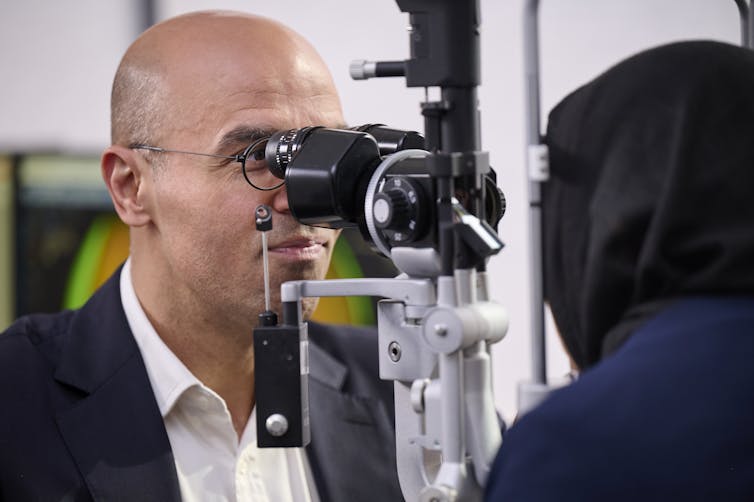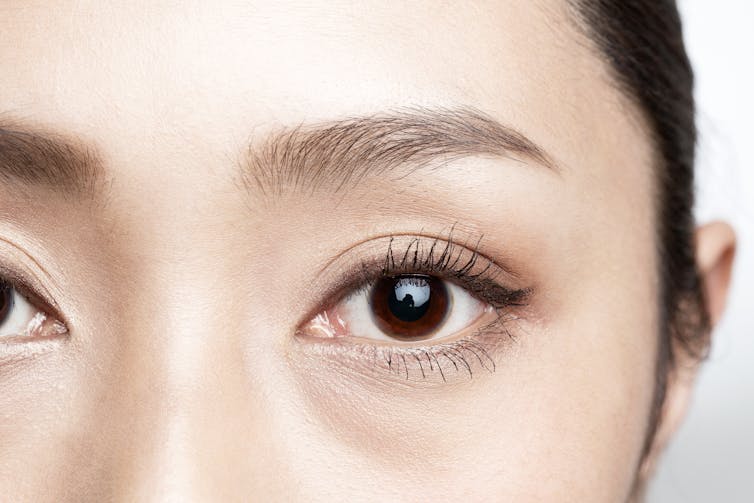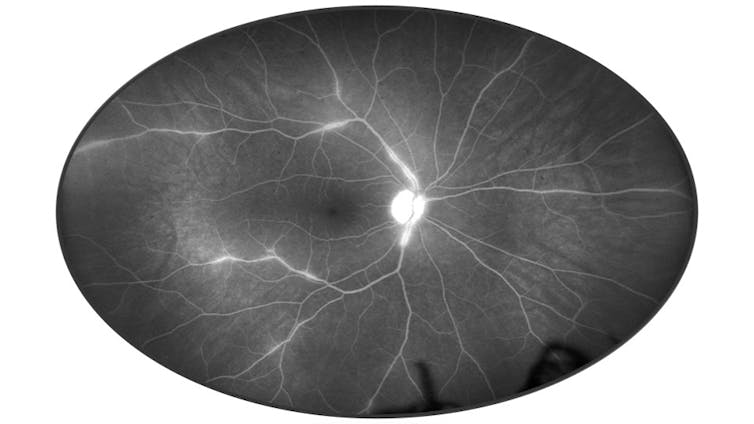My first encounter came as a medical student. Under high magnification, I examined a colleague’s iris, the coloured part of their eye encircling the pupil.
I watched as the muscle fibres moved rhythmically, undulating between dilation and constriction. It looked like an underwater plant, swaying in a current.
Mesmerising. But in a busy university curriculum the experience quickly faded, to be replaced by the next clinical rotation. I forgot ophthalmology; “maybe orthopaedic surgery or emergency medicine are for me”, I thought.
But eyes returned, this time while I was a junior doctor in residency. Assisting in surgery, I observed a patient’s retina through an operating microscope. Here was a cinematic view of the orb, as if viewed from a spacecraft over a Martian landscape.
The internal surface glowed blood orange (the colour once ascribed to its rich blood supply, now attributed to a layer of underlying pigmented cells). Within this landscape ran red rivulets, a network of branching blood vessels.
The Greek anatomist Herophilus thought this pattern resembled a casting net, leading to “retiform” (meaning reticular or netlike), which became “retina” in contemporary language (the light-sensitive film at the back of the eye). I was struck by the intricacy of this secret globe, this gallery of miniature art.
The term “beauty is in the eye of the beholder” took on new connotations, and I turned to pursuing ophthalmology. Aside from the organ’s intrinsic appeal, I was struck by the technicality of eye surgery, and the apparent mystique of ophthalmologists themselves.
These unruffled surgeons appeared to float above the general fray, waltzing around the hospital with fancy eye equipment and clever jargon. No one really knew what they did, but they looked cool.
Acceptance into ophthalmology specialist training was notoriously competitive, with only one or two doctors accepted each year in our state. “Why not,” I thought, and went for it, planning my campaign for eligibility. Among other things, this included me experiencing blindness for 24 hours, by using a blindfold as part of a fundraising event, and conducting research on childhood eye disease in Iran, my country of origin.
Nine years later I was a qualified ophthalmologist, having learned the eye’s workings in both health and when diseased. I had come to view the eye as an engineering and biological miracle.

Mammals with seeing brains
A wonderfully elastic ball, the eye can be thought of as housing a camera at the front. This camera focuses incoming light through compound lenses (the cornea and crystalline lens), which are separated by an aperture (the pupil), to form a fine beam.
This beam travels towards a transducer (an electronic device turning one form of energy into another) at the back of the eye (the retina). The transducer converts photons into electrical signals at a rate of around 8.8 megabits (million bits) per second, just shy of a decent ethernet connection.
Carried in an insulated cable (the optic nerve), this electrical current runs backwards through the brain, to the visual cortex. This is the part of the brain that sits just in front of the bony bulge at the back of your skull.
Here is vision’s supercomputer, where incoming, semi-processed data is organised into a final experience of shapes, colours, contrast and movement. Et voila, there you have it: high-definition, stereoscopic human vision.

While the front part of the eye is mainly composed of water, the back is nature’s version of bioelectronics (the convergence of biology and electronics).
Eyesight, then, is an interplay of light, water and electricity, in networks both elemental and complex. This exquisite balance may be further demonstrated through two examples.
First, consider the structure of the cornea. This is the clear “windscreen” at the front of the eye, the only completely transparent tissue in the human body. Its living cells are a plexus of water and collagen, glass-like and liquid enough to permit light, sturdy enough to withstand trauma. Here again lies a balance between the eye’s delicacy and its resilience.
Second, let’s look at the eyes’ development, as direct extensions of our brains. When we are embryos from weeks three to ten, two folds appear on our forebrains (the forward-most portion of our brain). These folds extend forwards, becoming stalks. In turn, they are capped with little cups that turn into globes, later encased in eyelids and lashes.
The brain stretches forward, in other words, to form its own eyes. It’s brain tissue, then, that watches the world – we are the mammals with seeing brains.
Photographs revert to negatives
The descriptions above could perhaps be characterised as a meeting of science and lyricism. This is no accident. While ophthalmology concerns itself with optics, a mathematical affair, I was the schoolkid who loved English class.
Whether writing short stories, or nodding to hip-hop’s street poetry, I was drawn to language. These days I’m predominantly a doctor and family man, and only a dilettante as a writer. Still, I seek language out in the micro-gaps of a day, predawn before the kids wake, or on train rides to and from work.
There’s nothing glamorous about this, and nor is it special. Doctor-writers are far from rare – think of history’s Anton Chekhov or William Carlos Williams, the US’s Atul Gawande, or our own Karen Hitchcock or Michelle Johnston. So far, I’m the only writerly eye surgeon I know of (any others out there – shout!).
Author Margaret Lobenstine believes this sort of “renaissance soul” resides in all of us; after all, we have two cerebral hemispheres, one for reason and one for art (in truth though, the hemispheres cooperate on most tasks).
Let’s pivot fully from eyeballs to writing then, and specifically to poetry, my favoured sandpit.
Robert Frost said, “to be a poet is a condition, not a profession”. Most poets write, I believe, because they must, not because it’s fun or easy (although occasionally it’s both). Sometimes we write to understand or at least to name something, to gather up the events and emotions that move us, dangling like threads to be spooled up into something resembling sense.
In a medical day, I am periodically struck by a patient encounter that leaves me reeling. Perhaps it’s an unexpected confession, or a scrap of a life story. Either way, it’s the emotional charge that, like a vein of gold, points towards a buried poem.
Let’s take a real-life example from my practice, an elderly lady whom we shall call Iris (pun intended).
Iris presents to me with failing vision. Examining her eyes, I see “geographic atrophy”, little islands of missing retinal tissue worn away over time. This is a form of incurable, age-related, macular degeneration. It results in permanent loss of central vision, with peripheral vision remaining intact.
It’s not good news; my stomach tightens as I prepare to deliver it.
Iris replies, tearily, that she just lost her husband of 60 years. She’s now alone and becoming blind. I’m taken aback – what can one honestly say to this?
Sure, there are visual magnifiers, home modifications, other practical aids that may guardrail her physical safety. But her anguish goes beyond this; she’s on the edge of a personal precipice, and teetering. There’s electricity in the consult room, a lightning-rod moment for sure.
How might a poet view this scene? Placing Iris in the centre, let’s start with her appearance – her auburn-dyed hair, her knobbly walking stick, her potpourri perfume – enough to make her real. In addition to portraiture, poetry deals in metaphors; what are some for Iris’s grief?
How about:
Colour photographs revert
to their negatives, old-fashioned film
stark and inverting reality,
her life recognisable
yet draining of hue.
Or this:
Turned over, her hourglass
clumps onto the table,
sand trickling away
from having had, towards loss, the two bulbs
painfully, inextricably linked.

Good poetry must go further, seeking the patterns beneath the surface. What precisely is it about Iris that moves me so? She is losing things, important things. Witnessing this touches my deepest fears, knowing that, like an unwelcome house guest, loss visits us all, sometimes staying for good.
As my Persian countryman Rumi wrote, “this human being is a guest house”. Losing our own physical abilities or our loved ones, what would become of us?
Distilling this further, what exactly is loss, its weight and texture?
Inversions,
your cherished glass of shiraz shatters
on the tiles, your laden table
upended. Warmth whistles
out through the cracks, cold rises up.
Midnight:
your reasons for living dwindle,
walking out the door
one by one.
Dark, heavy material no doubt; well, welcome to medicine, and to real life. No wonder Iris’s visit rattles me. The poet must face this discomfort, exploring the interplay between the miniscule and the panoramic, the worldly and the transcendent.
Tasked with creating visions for life, from its mundane to its profoundest moments, poets, then, are our seers.
Anger and solace
I’m now in my 18th year working exclusively with eyes, the latter half as a qualified consultant ophthalmologist. These days, the toughest conditions I face are diseases without a cure, such as Iris’s geographic atrophy, or vision loss that could have been prevented, such as solar retinopathy.
In other scenarios, there are eye diseases caused by modern living. An example of this is diabetic eye disease, which disproportionately affects Indigenous people. When compared with non-Indigenous people, Indigenous Australians suffer three times the rate of vision loss from diabetes.
The reasons for this are manifold, and include the easy access to sugar-laden beverages in many Indigenous communities. As ophthalmologists, we deal with the downstream effects of high blood sugar levels. This manifests as “diabetic macular oedema”, where a swelling at the back of the eye leads to loss of vision.
Fortunately, we have good treatments for this condition. But prevention is far better than cure. As one measure, why don’t we impose a sugar tax, as more than 100 other countries have done?. By introducing refined sugars into a healthy traditional diet, modern Australia has arguably created this problem. By corollary, we have a duty to solve it.
This is an opportunity for resistance and empowerment.
Hauled over on ships,
white crystals in barrels -
dispossession’s sweetener - now
sat on shelves, bright bottles
singing cheap songs
to thirsty eyes.
We’ll brand you yet:
mark your barrels ‘poison’.
Conditions like this, where modern society harms people – for astronomical corporate profits, mind you – are infuriating.
Thankfully, there is solace in my ongoing fascination with the eye. There are moments of sheer beauty; images of fluorescein angiography, for example, where the retina’s blood vessels are highlighted with a fluorescent dye as a diagnostic tool.
These angiograms remind me of lightning storms in our state’s northwest, where cloud-to-cloud and sheet lightning flash in the night sky in split-second forks and streams. Much as power and charge flow in the sky, so blood is distributed in the back of the eye.

Also spurring me on are patients’ success stories, where sight is restored or blindness prevented.
Twenty years in a Thai refugee camp,
now sat in front of me,
grandma from Myanmar.
Twenty years to lose light –
this cataract surgery won’t
return your nation, grandma, but at least
it’s restored your sight.
These stories abound, such is the privilege of my profession.
A race between science and time
There may even be hope for Iris. Her condition, geographic atrophy, is caused in part by her immune system, and its complement proteins. This network of proteins marks selected entities (typically pathogens or tumour cells) for destruction by immune cells such as lymphocytes, phagocytes and macrophages.
For reasons including localised inflammation and reduced oxygen delivery, this response can, in ageing, be misdirected towards healthy retinal tissue, leading to its destruction – a process akin to friendly fire in battle.
For Iris, the cavalry may be cresting the hill. In 2023, two new medications were approved for the treatment of geographic atrophy in the US. Both block targets within our complement system and, while not curative, have been shown to slow (although not reverse or stop) the disease. By late 2024, we should know whether one of these drugs, pegcetacoplan, is approved in Australia.
Starter’s pistol fires! A race afoot
between science and time.
Do the molecules work
and – as the clock chimes –
will they cross the line
to save sight?

